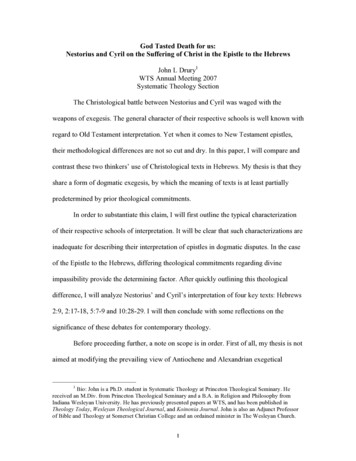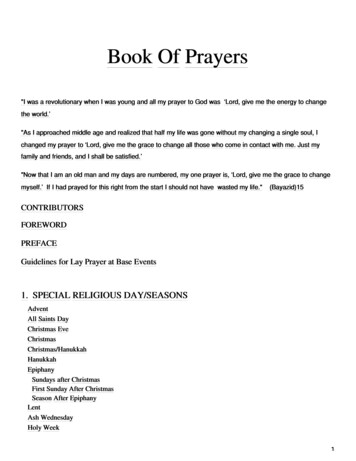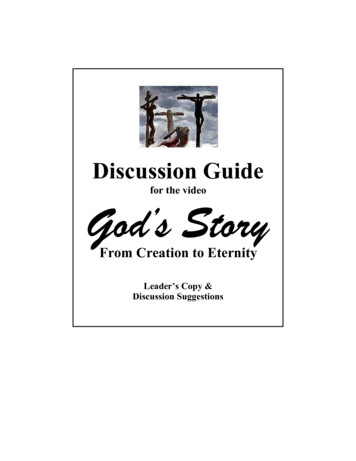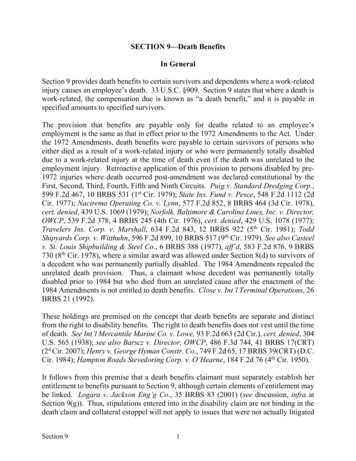
Transcription
God Tasted Death for us:Nestorius and Cyril on the Suffering of Christ in the Epistle to the HebrewsJohn L Drury1WTS Annual Meeting 2007Systematic Theology SectionThe Christological battle between Nestorius and Cyril was waged with theweapons of exegesis. The general character of their respective schools is well known withregard to Old Testament interpretation. Yet when it comes to New Testament epistles,their methodological differences are not so cut and dry. In this paper, I will compare andcontrast these two thinkers’ use of Christological texts in Hebrews. My thesis is that theyshare a form of dogmatic exegesis, by which the meaning of texts is at least partiallypredetermined by prior theological commitments.In order to substantiate this claim, I will first outline the typical characterizationof their respective schools of interpretation. It will be clear that such characterizations areinadequate for describing their interpretation of epistles in dogmatic disputes. In the caseof the Epistle to the Hebrews, differing theological commitments regarding divineimpassibility provide the determining factor. After quickly outlining this theologicaldifference, I will analyze Nestorius’ and Cyril’s interpretation of four key texts: Hebrews2:9, 2:17-18, 5:7-9 and 10:28-29. I will then conclude with some reflections on thesignificance of these debates for contemporary theology.Before proceeding further, a note on scope is in order. First of all, my thesis is notaimed at modifying the prevailing view of Antiochene and Alexandrian exegetical1Bio: John is a Ph.D. student in Systematic Theology at Princeton Theological Seminary. Hereceived an M.Div. from Princeton Theological Seminary and a B.A. in Religion and Philosophy fromIndiana Wesleyan University. He has previously presented papers at WTS, and has been published inTheology Today, Wesleyan Theological Journal, and Koinonia Journal. John is also an Adjunct Professorof Bible and Theology at Somerset Christian College and an ordained minister in The Wesleyan Church.1
John L DruryGod Tasted Death for usdifferences.2 Rather, it is intended to supplement this view in a case where it does notapply. Secondly, this paper does not offer a history of Hebrews interpretation.3 Attentionis focused exclusively on Nestorius’ and Cyril’s use of key texts rather than theirhistorical antecedents. Finally, for the sake of charitable interpretation as well as ease, Ihave selected Nestorius’ Bazaar of Heracleides and Cyril’s On the Unity of Christ as thefocus of comparison.4 These represent mature extended works of the two thinkers underinvestigation.Two Schools of Exegesis: Alexandria and AntiochThe conflict between Cyril, Patriarch of Alexandria, and Nestorius, student of thefamed Antiochene Theodore of Mopsuestia, continued an ongoing power strugglebetween two great theological schools of the early church. The intellectual locus of thisstruggle was the proper interpretation of the Bible. Do the words of Scripture permit andeven invite allegoria that leads the soul to multiple layers of spiritual truth? Or do wefind in the narratives and images of the Bible theoria that can be applied across time andplace? The Alexandrian tradition as developed by Clement and Origen opted forallegoria, while the Antiochenes Diodore of Tarsus and Theodore of Mopsuestiadefended theoria.5 Into these respective schools Cyril and Nestorius were initiated.62For an attempted revision of the typical view by means of comparative exegesis of the MinorProphets, see Hieromonk Patapios, “The Alexandrian and the Antiochene Methods of Exegesis: Toward aReconsideration” Greek Orthodox Theological Review 44:1 (1999) 187-198.3For an overview of Hebrews interpretation during the Patristic period, see Rowan A. Greer, TheCaptain of our Salvation: A Study in the Patristic Exegesis of Hebrews (Mohr: Tübingen, 1973).4Nestorius, The Bazaar of Heracleides (Driver, G. R. and Hodgson, L. eds. and transl.; Oxford:Oxford University Press, 1925) hereafter cited in-text; Cyril of Alexandria, On the Unity of Christ(McGuckin, John A., transl.; Crestwood, NY: St. Valdmir’s Seminary Press, 1995) hereafter cited in-text.5For a concise summary of the differences between these two schools and their representativefigures, see Karlfried Froehlich, Biblical Interpretation in the Early Church (Philadelphia: Fortress, 1984)15-23.6For a study of Cyril’s unique appropriation of Alexandrian exegesis, see Alexander Kerrigan, St.Cyril of Alexandria: Interpreter of the Old Testament (Rome: Pontificio Istituto Biblico, 1952).2
John L DruryGod Tasted Death for usThe methods of allegoria and theoria were especially helpful in cases ofanthropomorphism (e.g., the “hand” of God) or historical obscurity (e.g., Jewish foodregulations). But how did these two schools approach New Testament argumentativematerial? During the Fifth Century debate over Christology, thinkers from both schoolsturned to such texts where neither allegoria nor theoria would settle the debate. Someother method was needed.Despite the sharp division between Antioch and Alexandria over Biblicalinterpretation, in the midst of doctrinal debate Nestorius and Cyril shared the samemethod. They both made use of well-worn “dogmatic exegesis.” Such a method assumescertain texts refer to the doctrinal matter at hand. Debate surrounds the question as towhich aspect of the doctrine they refer. Athanasius used this method famously against theArian citation of Philippians 2 by asserting that the “lowering” in the passage referred tothe humanity, not the deity, of Christ. The same kind of dogmatic logic is at work inNestorius’ and Cyril’s treatment of key Christological passages in the Epistle to theHebrews. The significance of such a procedure is that theological assumption replacesmethodological principle as the determining factor. In light of the significant role playedby prior theological commitments, I will outline the basic doctrinal debate betweenNestorius and Cyril before turning to specific exegetical examples.The Center of the Christological Debate: Divine ImpassibilityWhat theological assumptions did Nestorius and Cyril bring to the interpretationof a New Testament epistle? Although the subtleties of the Christological controversyremain contested, the basic contours of the debate are clear. In response to a questionabout pious language for Mary, Nestorius rejected theotokos and recommended3
John L DruryGod Tasted Death for usChristokos. Cyril rushed to the defense of theotokos language, and the discussionescalated to debate over the relation of deity and humanity in Christ. The subsequent stirled to the Council of Ephesus after which – not without intrigue – Nestorius wascondemned.7In the course of the debate, Nestorius emerged as the defender of the distinctionbetween deity and humanity in Christ – hence Mary as Christokos. 8 Cryil, on the otherhand, stressed the unity of deity and humanity in Christ.9 Although such generalizationsare accurate, they do not reveal what was at stake in the debate. If it were simply a matterof emphasis, room would have been more easily made for both positions. The issue athand was divine impassibility. It seemed intuitively obvious to all parties involved that ifGod suffered, then God would cease to be God.For Nestorius, the way to defend divine impassibility was to hold the line on thedistinction.10 If God were united wholly with a human being, God would suffer andtherefore cease to be God. Nestorius says to Cyril, “[Y]ou evacuate him of impassibilityand of immortality” (39). The whole idea of an incarnation of God falls apart if Godceases to be God in the process. A suffering God is no better than the pagan gods.Cyril too affirmed divine impassibility, but did not share Nestorius’ fears. Cyrilthought it sufficient to simply specify that the Logos suffered in the flesh (115). No7For a detailed narration of the controversy, see John Anthony McGuckin, St. Cyril of Alexandria:The Christological Controversy: its History, Theology, and Texts (Leiden: E.J. Brill, 1994) ch. 1. For aretelling from an imperial perspective, see Kenneth G. Holum, Theodosian Empresses: Women andImperial Dominion in Late Antiquity (Berkeley: University of California Press, 1982) ch. 5.8For an analysis of Nestorius’ Christology, see J. A. McGuckin, St. Cyril of Alexandria ch. 2.9For an analysis of Cyril’s Christology, see J. A. McGuckin, St. Cyril of Alexandria ch. 3.10Donald Fairbairn agrees that divine impassibility was at the center of the debate in“Theopatheia: Nestorius’ Main Charge against Cyril of Alexandria,” Scottish Journal of Theology 56(2003): 190-207. Joseph M. Hallman also traces the significance of divine suffering the Christologicalcontroversy in “The Seed of Fire: Divine Suffering in the Christology of Cryil of Alexandria and Nestoriusof Constantinople,” Doctrinal Diversity: Varieties of Early Christianity (Everett Ferguson, ed.; New York:Garland, 1999) 71-93. Unfortunately for our purposes, neither scholar gives extended attention to theinterpretation of key texts in Hebrews.4
John L DruryGod Tasted Death for usstronger distinction was needed, provided one was careful with the language. The focuscould remain on the divine-human unity of Christ and the gracious act whereby God “didnot disdain the poverty of human nature” (55).As we shall see, these disparate theological commitments become the determiningfactor in each theologian’s interpretation of Scripture. When Nestorius encounters a textimplicating God in suffering, he ensures that the suffering is borne by the human Jesus indistinction from the divine Logos. In the face of the same texts, Cyril must find a way tosimultaneously affirm divine impassibility and the divine-human unity of Christ. I willdeal with four key texts of this sort found in the Epistle to the Hebrews.Comparative Exegesis of Hebrews 2:9The majority text of Hebrews 2:9b reads “Jesus, because of the suffering of deathcrowned with glory and honor, that by the grace of God he might taste death foreveryone” (NASB). This is a classic text on the suffering of Jesus. At first glance, thereseems to be nothing interesting here, for neither party questioned the suffering of thehuman Jesus. It is this very textual simplicity, however, that shows how Nestorius andCyril make dogmatic use of any text at hand.Although we do not have an extant reference to Hebrews 2:9 in Nestorius’ corpus,it was a favorite text of Theodore of Mopsuestia.11 Furthermore, Cyril cites the text in anexplicit rebuttal to his opponent’s interpretation of it (113). What is intriguing about thetext is that a minority textual tradition found in Antioch reads χωριs θεου (“withoutGod”) rather than χριτι θεου (“by the grace of God”).12 It is likely that Nestorius11In a fragment of his commentary on Hebrews, Cyril implicitly attacks the Christology ofTheodore of Mopsuestia while expositing Hebrews 2:9. See P. M. Parvis, “Commentary on Hebrews andthe Contra Theodorum of Cyril of Alexandria,” Journal of Theological Studies 26 (Oct 1975) 415-419.12For a text-critical overview of Hebrews 2:9, see Bart D. Ehrman, The Orthodox Corruption of5
John L DruryGod Tasted Death for usencountered this version and saw it as a definitive proof-text that the human Jesussuffered as a distinct subject from the divine Logos.Cyril directly combats such an interpretation of Hebrews 2:9. Although thesubject of the suffering in the verse is clearly Jesus, Cyril quotes the verse in context toshow that the whole passage is speaking about the divine Son who became like us for alittle while. Cyril claims that the author “makes it obvious to whom his words refer,clearly the Only Begotten” (114). Cyril makes a dogmatic exegetical move by specifyingthe referent of suffering as the divine Logos. He goes on to note that the Word “is notgiven on behalf of us nakedly, as it were, or as yet without flesh, but rather when hebecame flesh” (114). This important qualification makes it possible for him to conclude,“To say that he suffered does no disgrace to him, for he did not suffer in the nature of thegodhead, but in his own flesh” (115). By making these specifications, Cyril is able toascribe suffering to the Logos while retaining the impassibility of divine nature.Although the bare text seems to say very little on the matter, both sides of theChristological debate take Hebrews 2:9 as an opportunity to make doctrinal assertions.The minority status of the χωριs tradition suggests those who wished to defend divineimpassibility tampered with the text. God tasting death apparently left a bad taste in theirmouths. Cyril’s extended treatment reveals the lengths to which he will go to both affirmthe suffering of the Logos and at the same time defend divine impassibility. He wants tosee God really taste death yet without ceasing to be the immortal God. Both are cases ofScripture: The Effect of Early Christological Controversies on the New Testament (Oxford: OxfordUniversity Press, 1996) 146-150. The variations in Syriac Bibles follow variants of Greek the manuscripttradition. See Sebastian P. Brock “Hebrews 2:9 in Syriac Tradition,” Novum Testamentum 27 (Jul 1985):236-244 as well as a more concise discussion in The Bible in the Syriac Tradition (Kerala, India: St.Ephrem Ecumenical Research Institute, 1989) 30.6
John L DruryGod Tasted Death for usdogmatic exegesis: the crux of the argument surrounds the precise theological referent ofScriptural words.Comparative Exegesis of Hebrews 2:17-18Hebrews 2:17-18 is another text referencing the suffering of Christ. It reads:“Therefore, he had to be made like his brethren in all things, that he might become amerciful and faithful high priest in things pertaining to God, to make propitiation for thesins of the people. For since he himself was tempted in that which he has suffered, he isable to come to the aid of those who are tempted” (NASB). Although the text makes asimple allusion to Christ’s solidarity with us in suffering, both Nestorius and Cyril see inthis text an opportunity to advance their respective views.Nestorius quotes these verses in the context of defending his distinction betweenChrist’s human body and the God who enlivens it. Referring to the body as the temple, hestates, “I called the temple passible and not God the quickener of the temple which hassuffered” (228-29). It is crucial for Nestorius that the suffering of Christ is attributedwholly to the human prosopon. He proceeds to vindicate himself by claiming, “For thisyou have condemned me like the priests for blasphemies, because I have said that God isincorruptible and immortal and the quickener of all” (229). This is a clever defense, forNestorius claims that he is condemned for defending the deity of God – a worthy task inanyone’s mind. For Nestorius, the subject of the suffering in Hebrews 2:17-18 is clearlyhuman, not divine.Cyril finds in this very same verse justification for his own views. His line ofargument is relatively straightforward: if Christ became like us, then at some point hemust not have been like us. As Cyril succinctly puts it, “For whatever is ‘made like’7
John L DruryGod Tasted Death for uscertain other things, must of necessity be different from them, unlike them, indeed of adifferent form or nature to them” (64). Hence the language of becoming in this textimplies that the real subject of the suffering spoken of in this passage is the Logos. Afterquoting this passage, he delineates one of his characteristic lists of paradoxes:And this likeness in all things has a kind of beginning, or as the inception of theaffair, his birth from a woman; his revelation in the flesh, even though in terms ofhis own nature he is invisible; his abasement in the human condition for theeconomy of salvation, even though he has the transcendent name; his humbling tomanhood, even though he is raised high above the Thrones; and his acceptance ofservile limitations, even though he is by nature the Lord (Phil 2:6f). And all thisbecause ‘The Word was God’ (58).Such a conjunction of opposites is the key to Cyril’s logic. By means of paradox, Cyrilaims to affirm both the suffering of the divine Logos in the flesh and the impassibility ofGod.Cyril’s use of paradox could be construed as a smokescreen for sloppiness.However, Cyril’s language does not lack precision. Though his focus is on the unity ofdeity and humanity, he is still careful to make distinctions when necessary. Cyril quotesHebrews 2:17 in support of this rather precise statement: “Just as we say that the fleshbecame his very own, in the same way the weakness of that flesh became his very own inan economic appropriation according to the terms of the unification” (107). Cyril has nointerest in speaking of divine suffering in general, but rather as a specific economy of theSon in a specific mode of union. So, although Cyril’s appeal to paradox is at the center ofhis argument, it is no mere rhetoric or an excuse for theological sloppiness.In their respective treatments of Hebrews 2:17-18, both Nestorius and Cyril showtheir similar method of dogmatic exegesis. Both extend the referent of the text into theirtheological dispute. Nestorius sees the passage as referring to human suffering in8
John L DruryGod Tasted Death for usdistinction from the divine. Cyril sees the divine Logos as the referent of the passage andtherefore the subject of the suffering described. Both find support for their opposeddoctrinal formulations in the same text.Comparative Exegesis of Hebrews 5:7-9Hebrews 5:7-9 is another key passage that describes the suffering of Christ. Thedebate surrounding this text reveals the classical understanding of suffering as any and allpassivity in contrast to activity. It reads:In the days of his flesh, he offered up both prayers and supplications with loudcrying and tears to the one able to save him from death, and he was heard becauseof his piety. Although he was a son, he learned obedience from the things whichhe suffered. And having been made perfect, he became to all those who obey himthe source of eternal salvation (NASB).Despite the relatively “high” Christology of the Epistle to the Hebrews, this particularpassage describes a thoroughly human Jesus.This is a perfect passage for Nestorius to press the distinction between deity andhumanity in Christ. He quotes it often. He links it with Luke 2:52, “Jesus increased instature and in wisdom” (244). These verses picture Jesus as a man who in his sufferingdevelops and is perfected. It is no wonder that Nestorius had to defend himself against thecharge of adoptionism. He blocks this charge by affirming that the Logos was in and withthe human Jesus all along (99). Rather than disparage the deity of Christ, Nestorius citesthis passage to affirm the full humanity of Christ: “But if thou callest the nature of men inhim whole, attribute unto him completeness also in the operations wherein it seems that itexists, that is, that he trusted in God and was made chief priest” (248). In an extendedexposition of this text, he takes the opportunity to emphasize the distinction between theSon who has “authority in his sonship,” and the humanity, “which from birth had to9
John L DruryGod Tasted Death for usbecome the Son through the union and which had not authority but obedience” (251). Atthis point Nestorius is extending the reference of the text to make the necessary complexdistinctions for his Christology.Given that such distinctions are not clearly visible at the surface of the text, onemight suspect that Cyril would use this text as one more example of the divine Logossuffering along with us. However, the suggestion that the Logos learned and wasperfected understandably troubled Cyril. He acknowledges the challenge that if Christ“could no longer bear his sufferings but was overcome by fear and mastered byweakness, then he assuredly convicts him of not being God” (104). But since he has goneto great lengths to make so many other suffering passages refer to the united Logosincarnate, he does not want to back off at such a crucial text. Cyril here encounters acommon problem of dogmatic exegesis: once you have secured the referent of anilluminating passage, another passage emerges to muddy the waters.What is Cyril’s solution? He adopts a subtle strategy whereby such actsunbecoming of God are borne for our sake. Scriptural descriptions of the Logos beingtempted or learning obedience are there to “let us look into the profundity of thiseconomy insofar as is possible” (102). In other words, such lowly passions areexpressions of the lengths God will go for us. Once again, Cyril uses the language ofeconomy to limit these descriptions to the Logos-made-flesh rather than God in general.Cyril turns the focus away from the challenge to the divine-human unity of Christ andputs the spotlight on what God was doing for us.Cyril extends this strategy by appealing to the logic of moral example. He says,“But insofar as temptation attacks all those who are put in danger because of the love of10
John L DruryGod Tasted Death for usGod, then it was necessary for us to learn how people ought to behave once they havedecided to live an honorable life in exemplary conduct” (102). He goes on to say that “itwas also necessary for us to have the beneficial knowledge of how far the limits ofobedience should extend” (102). Cyril paints God as a moral exemplar: “And so theWord of God became an example for us in the days of his flesh, but not nakedly oroutside the limits of self-emptying” (103). Cyril concludes that this divine pedagogicalintention explains the seemingly unbecoming descriptions of Hebrews 5:7-9: “This waswhy he extended his prayer, and shed a tear, at times even seemed to need a saviorhimself, and learned obedience, while all the while he was the Son” (103). He reminds usthat the “beautiful and helpful example of this action was for our sake” (103). So Cyrilavoids an otherwise difficult Christological text by turning the focus away from theconstitution of Christ and onto his economic example for us.As before, both Nestorius and Cyril emerge as dogmatic exegetes of the sameportion of Scripture. Nestorius rightfully saw in Hebrew 5:7-9 a great opportunity todevelop and defend the full humanity of Christ. Yet he extends the reference of thepassage to further explain his distinction between the deity and humanity of Christ. Cyrilrecognized the challenge this text posed for his position. In light of this, he adopts astrategy that focuses on the external relation of Christ to us as example rather than theinternal relation of humanity and deity in Christ. Both Nestorius and Cyril find ground toadvance their position in Hebrews 5:7-9.11
John L DruryGod Tasted Death for usComparative Exegesis of Hebrews 10:28-29One last example will show how even the passing rhetoric of the Epistle to theHebrews was used by Nestorius and Cyril in their Christological controversy. In one ofthe parenetic passages of Hebrews, the author warns his audience:Anyone who has set aside the Law of Moses dies without mercy on the testimonyof two or three witnesses. How much severer punishment do you think he willdeserve who has trampled under foot the Son of God, and has regarded as uncleanthe blood of the covenant by which he was sanctified, and has insulted the Spiritof grace (Heb. 10:28-29 NASB)?Although a simple call to respect for the work of Christ, the phrase “trampled under footthe Son of God” became a locus of doctrinal controversy.Nestorius cites this passage in an extended argument from the Eucharist on behalfof his Christology. He applies the text by stating, “[T]o those who thought the body of theSon of God was polluted the Apostle says that they are trampling underfoot the Son ofGod in rejecting him and denying him, against those who confess that the body is of ourown nature and who regard it as polluted” (32-33). Here he is not attacking Cyril directly.However, he is taking the opportunity to prove that he can affirm the full humanity ofChrist without attributing to him a sinful nature. After an earlier citation of verses 28-29,Nestorius critiques those who say that “the body of the Son of God is the body of a man,whose body and blood he has raised to his own ousia and has not let them be upbraidedand taunted with a human ousia but has [caused them] to be adored in his own ousia”(29). Here Nestorius presses the point of distinction between the human body and thedivine ousia.Cyril sees this passage making the exact opposite point. After quoting Hebrews10:28-29, he argues that the trampled body is not the common body of a common man12
John L DruryGod Tasted Death for usbut the body united with the Logos. He concedes that if Nestorius’ Christology werecorrect, the body would be so common: “Yet if it was not really the precious blood of thetrue Son made man, but rather of some bastard son different from him, someone whoholds the sonship by grace, then how could one fail to conclude that it really was acommon thing?” (117). Cyril thinks otherwise. The body is truly owned by the Son ofGod. Yet, in a typical paradoxical twist, Cyril asserts, “[E]ven if he is said to suffer in theflesh, even so he retains his impassibility insofar as he is understood as God” (117). Cyrilwished to block Nestorius’ distinctions while at the same time affirm the impassibility ofGod.In this last case, one can see how Nestorius and Cyril can take passing rhetoric tohave dogmatic import. Nestorius uses the rhetoric of the text to combat his opponents.Cyril uses the same text to assert the unity of Christ. Both squeeze doctrinal content outof a rather simple warning passage.ConclusionBy means of comparative exegesis, I have shown that Nestorius and Cyril share adogmatic exegetical method when approaching the Epistle to the Hebrews in the midst ofdoctrinal debate. The typical characterization of their respective schools are foundwanting in this domain. Here, the key difference between them is not an exegeticalmethod, but a theological conviction: how to deal with the impassibility of God in thecontext of Christology. Nestorius believes he can defend the impassibility of God bystressing the distinction of deity and humanity in Christ. Cyril believes he canparadoxically hold on to both divine impassibility and the divine-human unity of Christ.Both must make clever exegetical moves to defend their positions Scripturally.13
John L DruryGod Tasted Death for usIs it possible in our day to appropriate or even appreciate these exegeticaltechniques? I would recommend a critical appropriation, one that takes into account thedifficulty of fixing the theological referent of an ancient text, while affirming the desireto view the Bible as actually talking about God. It is too easy to be dismissive of theexegetical gymnastics of Nestorius and Cyril without appreciating their imaginativepiety. If the church wishes to take seriously its theological heritage while tacklingcontemporary questions, it behooves us at least to reach for an approach to Scripture thatacknowledges its divine referent.What contemporary questions might this method serve? Fittingly, the question ofdivine suffering is once again on the theological agenda. The radical evil encountered inthe 20th Century has raised the question of God’s impassibility. Some contend that God’ssuffering with creation is an essential and affirming notion. Others have reminded us thatthe power of God over our suffering is a liberating truth. Nestorius and Cyril come to uswith wisdom on how to tackle such a problem.Nestorius’ strong defense reminds us that a God who is overwhelmed by sufferingis no good for us. Even if we choose to affirm divine passion, we must never forgetGod’s action on our behalf. Cyril affirms our search for the suffering of God, but with awarning to be precise.13 There is a lot of loose rhetoric about divine suffering that needsCyril’s careful touch. If God suffers, then we are required to the best of our ability to sayhow, where, and when this suffering occurs. Otherwise, our sloppiness will dampen ourconviction. So Nestorius and Cyril, despite their difference from each other and distancefrom us, can still speak wisdom in our day.13For further study on Cyril’s contemporary theological significance, see selected articles inThomas G. Weinandy and Daniel A. Keating, eds., The Theology of St. Cyril of Alexandria: A CriticalAppreciation (London: T & T Clark, 2003).14
John L DruryGod Tasted Death for usBibliographyBrock, Sebastian P. “Hebrews 2:9 in Syriac Tradition.” Novum Testamentum 27 (Jul1985) 236-244.Brock, Sebastian P. The Bible in the Syriac Tradition. Kerala, India: St. EphremEcumenical Research Institute, 1989.Cyril of Alexandria. On the Unity of Christ. McGuckin, John A., transl. Crestwood, NY:St. Valdmir’s Seminary Press, 1995.Ehrman, Bart D. The Orthodox Corruption of Scripture: The Effect of EarlyChristological Controversies on the New Testament. Oxford: Oxford UniversityPress, 1996.Fairbairn, Donald. “Theopatheia: Nestorius’ Main Charge against Cyril of Alexandria.”Scottish Journal of Theology 56 (2003): 190-207.Froehlich, Karlfried. Biblical Interpretation in the Early Church. Philly: Fortress, 1984.Hallman, Joseph M. “The Seed of Fire: Divine Suffering in the Christology of Cryil ofAlexandria and Nestorius of Constantinople.” Everett Ferguson, ed. DoctrinalDiversity: Varieties of Early Christianity. New York: Garland, 1999. 71-93.Holum, Kenneth G. Theodosian Empresses: Women and Imperial Dominion in LateAntiquity. Berkeley: University of California Press, 1982.Kerrigan, Alexander. St. Cyril of Alexandria: Interpreter of the Old Testament. Rome:Pontificio Istituto Biblico, 1952.McGuckin, John Anthony. St. Cyril of Alexandria: The Christological Controversy: itsHistory, Theology, and Texts. Leiden: E.J. Brill, 1994.Nestorius. The Bazaar of Heracleides. Driver, G. R. and Hodgson, L. eds.
of Bible and Theology at Somerset Christian College and an ordained minister in The Wesleyan Church. John L Drury God Tasted Death for us 2 . distinction from the divine Logos. In the face of the same texts, Cyril must find a way to simultaneously affirm divine impassibility and the divine-human unity of Christ. I will










